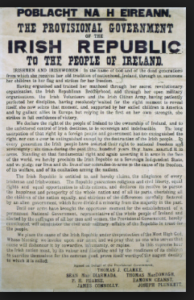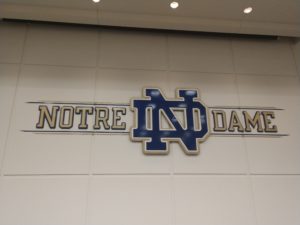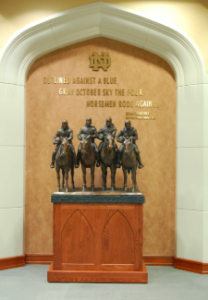In just 12 days time, the #3 Notre Dame Fighting Irish will play in the Cotton Bowl, one of this season’s two national semifinal contests, against the #2 Clemson Tigers. If the Fighting Irish, double digit underdogs, manage to pull off the massive upset they will play the winner of Alabama-Oklahoma for the national title.
It’s a historic moment for Notre Dame, their first College Football Playoff appearance. “Oh, it’s going to decide a true national champion, there’s no doubt about that,” Notre Dame Coach Brian Kelly said at the on-campus Playoff Media Day this past Saturday.
In this monumental moment, it’s the perfect time to reflect on all things Notre Dame history. For instance, how did they acquire the Fighting Irish nickname? Well, there isn’t a short simple answer to that, but it does have roots in the Easter Rebellion of 1916.
The Easter Rebellion, also known as the Easter Rising or simply The Rising was an uprising on Easter Monday 1916 in Dublin. It paved the way towards galvanizing public sentiment in Ireland to eventually fight for and later win independence from England.
According to the ND website, freedom fighter Éamon de Valera, a leader of The Rising who was sentenced to death but later granted amnesty, arrested by the English again, before later escaping to America “was welcomed as a hero at Notre Dame on October 15, 1919. Accounts in Scholastic, a student publication, indicate that his visit tilted campus opinion in favor of the “Fighting Irish” moniker — though not completely.”
Valera left behind a symbol of his visit, which was subsequently destroyed by a student sympathetic to the cause of the Ulster unionists. Which reminds us- is there a connection between the Syracuse Orangemen and the “Orangemen,” the followers of Dutch-born Protestant king William of Orange, who defeated the army of Catholic king James II in the Williamite–Jacobite War (1688–1691)?
We’ll save that exploration for another time.
Back to the story of the Fighting Irish, and as we inferred earlier- there is no straight line here connecting all the dots, but a lot of stories that feel true and seem true.
The Fighting Irish as a nickname for ND’s sports teams gained traction during the 1920s, and then in 1927 university president Rev. Matthew Walsh, C.S.C., “decided that the “Fighting Irish” was preferable to the school’s more derisive nicknames,” the university website says.
The statement included: “The university authorities are in no way averse to the name ‘Fighting Irish’ as applied to our athletic teams… I sincerely hope that we may always be worthy of the ideal embodied in the term ‘Fighting Irish.’”
What was the tipping point for the nickname? Was there a specific incident that clinched the immortal place of the Fighting Irish nickname?
What went down on a weekend in May of 1924 in South Bend was perhaps the deciding factor.
Members of the white supremacist Ku Klux Klan organization chose to stage a parade in South Bend, and the end result that Saturday was an epic fight between KKK members and Notre Dame students.
Comedians Dave Anthony and Gareth Reynolds, in their extremely popular and vastly successful podcast “The Dollop,” examined the day that the anti-Catholic Klan came to South Bend, got beaten down by a group of 2,000 Notre Dame students, and were then driven out of town.
Have a listen below:
You can’t hear this story and not become a Fighting Irish fan. It’s that great!
It even includes a couple football connections. ND students destroyed a glowing red cross the KKK had put up at their local headquarters, by throwing potatoes at it and knocking out all the red light bulbs.
However, there was one last red light bulb that they just could not demolish, and had spent over an hour trying to. That is until ND starting quarterback Harry Stuhldreher…well, you have to listen to the pod to find out what happens.
Given how Stuhldreher was a member of the legendary Four Horsemen backfield, perhaps this detail in the story is an example of the ancient Irish art of story telling. Some of the students, so The Dollop goes, also formed “a wedge,” yes the type that is now outlawed in football, during their street fight with the KKK.
Remember this was back when the Klan was at height of their power, and had membership in the millions.
Four of the five states with the largest Klan memberships (Pennsylvania, Ohio, Illinois and Indiana- which was #1) at the time were actually former Union, not Confederate states. Even the governor of Indiana was in the Klan at this time, a period in history where some estimated that 5% of American white men were members of the notorious terrorist hate group.
ND alumnus Todd Tucker wrote a book on the 1924 clash entitled “Notre Dame vs The Klan.”
The school website points out how Tucker’s book “traces the decline of the Klan in Indiana and the acceptance of the university and Catholics more generally in the US.”
So that’s the story, and we’re sticking to it in regards to the Fighting Irish nickname.
Paul M. Banks runs The Sports Bank.net, which is partnered with News Now. Banks, a former writer for NBC Chicago.com and Chicago Tribune.com, regularly appears as a guest pundit on WGN CLTV and co-hosts the “Let’s Get Weird, Sports” podcast on SB Nation.
He also contributes sociopolitical essays to Chicago Now. Follow him on Twitter and Instagram. The content of his cat’s Instagram account is unquestionably superior to his.





